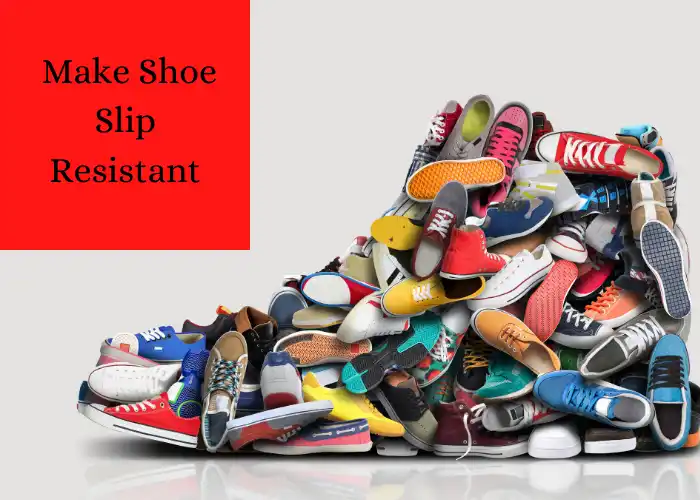Shoes are crucial in our daily lives. They can make or break an outfit, but it is even more important to buy shoes that you feel comfortable wearing for long periods.
Work shoes should be slip-resistant to avoid accidental slipping. You can tell if shoes are slip-resistant by looking at the sole tread.
Shoes that slip will cause slipping and discomfort, which will result in a bad day at work or school. You might have even fallen and had had a few bruises.
Reason for Slip-on Surface
Slip resistance relates to how easy it is for our feet to slide on the ground so that we lose our balance and fall.
This happens when your shoe’s sole doesn’t provide adequate grip or friction while walking.
For example, if you’re wearing high heels — even if they’re highly stylish — there might not be enough friction between the bottom of your shoe and the floor, causing you to slip.
Walking in wet or icy conditions can also create issues with footing leading to an increased potential for slipping.
Fortunately, there are several easy ways to make your shoes more slip-resistant, like wearing socks which I’ll discuss below, or several others.
How to Prevent it
To prevent accidents from slipping on wet surfaces, it’s essential to make shoes slip-resistant. There are a few different ways to do this, and they’re all easy.
Read on to find out about how to prevent your shoes from slipping so you can always look good and feel great!. These ways mentioned below are straightforward ways how to make shoes slip-resistant.
List of Things You Can Do to Make Shoes Slip Resistant:
1. For Plastic and Leather:
Apply a coat or two of clear nail polish (but don’t use the quick-dry kind). This might last for about an hour if you’re out on a wet floor, but you’ll need to redo it time and again throughout the day.
2. Use Rubber Glue for Fabric Shoes
For fabric shoes, use rubber glue, stick down strips around the sole (at least half an inch wide) underneath where your heel rests.
Make sure this strip covers the whole footed – any part of it sticking up could still cause slippage.
It is advisable to test this adhesive first. This usually works for the more casual type of dress shoes, not necessarily for business suits or formal wear where you need something sensible on your feet, but these are better than nothing!.
3. Use Heel Grips
Another solution is to buy some heel grips, which are available at any shoe store. Just cut them down the center and put one half on each side of your footed.
You can even get colored ones if you want or leave some uncovered so they still show beneath your dress shoes.
4. Wear Rubber Soles in the Summer Season
There are chances that rubber soles will help make your shoe slip-resistant, but it also depends on the rubber used.
If the rubber is very hard, it might not absorb any shock while walking or running, which may cause slipping problems.
So if you’re facing terrible days in summer seasons against slip-resistant, try wearing shoes with rubber soles instead of leather soles during summertime when it’s hot outside.
5. Upper Material
Another way to make shoes slip-resistant is by using upper materials like suede or leather; they provide a better grip than other materials like cloth or synthetic ones.
6. Shoe Laces
Shoelaces play an essential role in staying firmly attached to your shoe without letting them slip off while walking.
This can be done by using shoelaces made from an elastic material, which may expand and shrink when you walk or run.
7. Arch Support
This is an excellent way to make shoes slip-resistant by using arch support with rubberized material in the center of your shoe.
This will provide a good grip and prevent slipping at the same time. But if you don’t want it, you can permanently remove it later on when needed only.
8. Top Lace Hooks
Like regular hooks, top lace hooks also help stay attached to your feet while walking without letting them fall off from anywhere, which might cause serious injuries.
Wear Socks Made From Wool Or Other Fibers That Are Naturally Slip-Resistant
Wool socks are made from an animal’s hair with scales on the surface that cause it to resist slipping.
This helps sheep stay on top of slick or steep surfaces like damp grass, snow, or ice. It also makes them naturally slip-resistant.
When someone says “wool socks”, they’re typically referring to socks made with sheep’s wool, but there are other types of threads — such as alpaca wool and yak wool — that provide the same versatile benefits.
Alpaca wool, for example, is even softer than regular sheep’s wool, making it ideal for next-to-skin wear while retaining its slip-resistance properties. Other fibers have high resistance to slipping silk and linen.
You don’t necessarily have to choose wool, but if you want it to be slip-resistant, then the sock should contain some natural fiber that provides this benefit.
This is because other synthetic fabrics tend not to give any traction or grip on their own.

